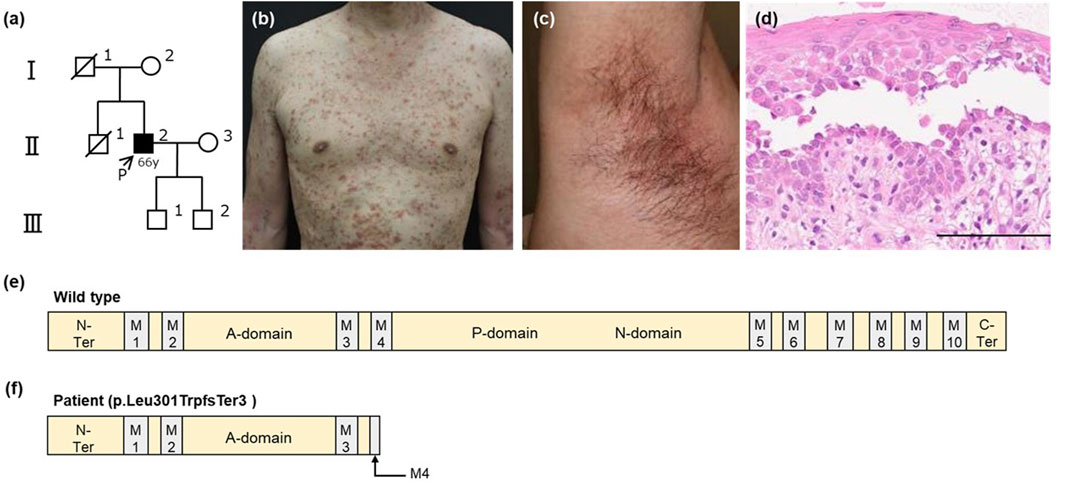- 1Department of Dermatology, The University of Tokyo Graduate School of Medicine, Tokyo, Japan
- 2Department of Cardiology, Tokyo Medical University, Tokyo, Japan
- 3Department of Clinical Genetics Center, Tokyo Medical University, Tokyo, Japan
Dear Editors,
Hailey-Hailey disease (HHD) is an autosomal dominant disease that was first described in 1939 by the Hailey brothers [1]. HHD is characterized by recurrent, erythematous, and vesicular plaques in flexural areas such as the axillae, groin and neck [1]. HHD is caused by variants of the ATP2C1 gene, which is located on chromosome 3q22 [2] and encodes the Ca2+/Mn2+-ATPase 1 pump (SPCA1) in the Golgi apparatus of keratinocytes. Although over 150 pathological variants in the ATP2C1 gene have been identified in HHD, no clear genotype-phenotype correlation has been established [3]. Here, we report a case of late-onset HHD with a novel frame-shift variant in the ATP2C1 gene.
A 66-year-old man presented with a two-year history of recurrent erythematous plaques on the trunk and extremities that were refractory to topical steroids. His medical history was remarkable for dyslipidemia, for which he had been taking pravastatin. His family history was unremarkable (Figure 1A). Physical examination revealed erythematous plaques with erosion on the trunk, axillae, groin, and upper extremities (Figures 1B, C). Laboratory investigations were unremarkable. Skin biopsy from the erythematous lesion on the abdomen revealed widespread intraepidermal acantholysis with a dilapidated brick wall appearance. The dermal papilla covered with one layer of basal cells projected into the cleft, forming villi-like structures (Figure 1D). Direct and indirect immunofluorescence was negative. After obtaining informed consent, targeted next-generation sequencing followed by Sanger confirmation was performed on genomic DNA from blood by Hybrid Capture at Tokyo Medica University Hospital, revealing a novel heterozygous frame-shift delete variant (c.902del, p.Leu301TrpfsTer3) in exon 12 of the ATP2C1 gene. This causes a premature termination codon 6 to 8 codons downstream of the variant site, leading to a severe truncation of SPCA1 at the fourth of 10 transmembrane helices [4] (Figures 1E, F). The diagnosis of HHD was made, and he started taking etretinate 30 mg/day without improvement. After the discontinuation of etretinate, oral cyclosporine 100 mg/day and prednisolone 20 mg/day (0.3 mg/kg/day) were started.

Figure 1. Clinical, histopathological, and genetic findings of the patient (A) Family pedigree. (B) Multiple erythema and hyperpigmentation of the trunk and upper extremities. (C) Erythema on the axilla. (D) Histopathology showing acantholysis with a dilapidated brick wall appearance (H&E staining, ×400). Scale bar = 100 µm. (E, F) Schematic representation of the domain of SPCA1 encoded by wild type (E) or frame-shift variant (F) in the ATP2C1 gene. N-ter, N-terminal domain; M1-10, the number of transmembrane domain; A-domain, actuator domain; P-domain, phosphorylation domain; N-domain, nucleotide-binding domain; C-ter, C-terminal domain.
Here, we report a sporadic case of HHD with a previously unreported heterozygous frame-shift variant (c.902del, p.Leu301TrpfsTer3) in the ATP2C1 gene. Considering that HHD usually develops in the third to fourth decade of life, the onset of symptoms in the 60s in our patient seems to be late. In addition, HHD usually presents with skin rash in flexural areas such as groin, axilla and neck, while our patient presented with the widespread rash on the trunk and extremities. These two atypical features may be associated with the novel variant in our patient.
Data availability statement
The original contributions presented in the study are included in the article/Supplementary Material, further inquiries can be directed to the corresponding author.
Ethics statement
Ethical approval was not required for the studies involving humans because this is a single case report. The studies were conducted in accordance with the local legislation and institutional requirements. The participant provided written informed consent to participate in this study. The human samples used in this study were acquired from a by-product of routine care or industry. Written informed consent was obtained from the individual(s) for the publication of any potentially identifiable images or data included in this article.
Author contributions
All authors listed have made a substantial, direct, and intellectual contribution to the work and approved it for publication.
Funding
The authors declare that no financial support was received for the research, authorship, and/or publication of this article.
Conflict of interest
The authors declare that the research was conducted in the absence of any commercial or financial relationships that could be construed as a potential conflict of interest.
References
1. Engin, B, Kutlubay, Z, Çelik, U, Serdaroğlu, S, and Tüzün, Y. Hailey-Hailey disease: a fold (intertriginous) dermatitis. Clin Dermatol (2015) 33:452–5. doi:10.1016/j.clindermatol.2015.04.006
2. Hu, Z, Bonifas, JM, Beech, J, Bench, G, Shigihara, T, Ogawa, H, et al. Variants in ATP2C1, encoding a calcium pump, cause Hailey-Hailey disease. Nat Genet (2000) 24:61–5.
3. Dobson-Stone, C, Fairclough, R, Dunne, E, Brown, J, Dissanayake, M, Munro, CS, et al. Hailey-Hailey disease: molecular and clinical characterization of novel variants in the ATP2C1 gene. J Invest Dermatol (2002) 118:338–43. doi:10.1046/j.0022-202x.2001.01675.x
Keywords: Hailey-Hailey disease, ATP2C1, novel variant, frame-shift variant, ATP2C1 gene
Citation: Iwata H, Kotani H, Kuzumi A, Inagaki N and Sato S (2024) Late-onset Hailey-Hailey disease with a novel frame-shift variant in the ATP2C1 gene. J. Cutan. Immunol. Allergy 7:13246. doi: 10.3389/jcia.2024.13246
Received: 12 May 2024; Accepted: 19 July 2024;
Published: 02 August 2024.
Copyright © 2024 Iwata, Kotani, Kuzumi, Inagaki and Sato. This is an open-access article distributed under the terms of the Creative Commons Attribution License (CC BY). The use, distribution or reproduction in other forums is permitted, provided the original author(s) and the copyright owner(s) are credited and that the original publication in this journal is cited, in accordance with accepted academic practice. No use, distribution or reproduction is permitted which does not comply with these terms.
*Correspondence: Ai Kuzumi, a3V6dW1pYS1kZXJAaC51LXRva3lvLmFjLmpw
†These authors have contributed equally to this work
 Hiroka Iwata
Hiroka Iwata Hirohito Kotani1†
Hirohito Kotani1† Shinichi Sato
Shinichi Sato